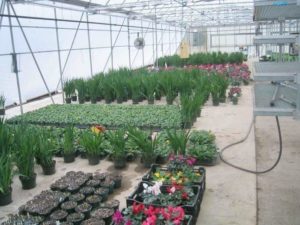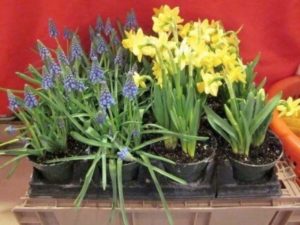Expanding a Greenhouse
by Gary Mount
This year we are expanding our greenhouse at Terhune Orchards. We first built the greenhouse 12 years ago. Prior to that we hadn’t grown very many of the plants that we sold. Mostly we bought them from others farmers for resale. But by growing our own plants, in our own greenhouse, we have just the right vegetable plants that we want to transplant. We can offer better quality plants, and — most of all — it’s more fun.
 Our original greenhouse was 50 by 48 feet — about 2500 square feet. It quickly became too small for the green thumb of the family, wife Pam. There are just so many nice things to grow! This year we are doubling the size to 50 by 96 feet — nearly 5000 square feet.
Our original greenhouse was 50 by 48 feet — about 2500 square feet. It quickly became too small for the green thumb of the family, wife Pam. There are just so many nice things to grow! This year we are doubling the size to 50 by 96 feet — nearly 5000 square feet.
We start our growing season with Freesia, a bulb that we make successive plantings of starting in September. They are the most fantastic plants, with long stems and multiple flowers lined up in a row, hanging off the top. Freesias originated in South America and are not widely grown in New Jersey. Many greenhouse growers have their greenhouses full of poinsettias in the fall and have no room to plant freesias. Pam and I have never gotten excited about growing poinsettias, so we have room. Freesias also take a long time to grow. The first ones are ready to sell in January.
 Along with freesia, we plant primrose and cyclamen — transported to the Farm Store for sale as they mature. At the same time, we also plant tulips, daffodils, tete-a-tete, and grape hyacinth. These bulbs take a side trip to the bulb cooler for a few months. The bulb cooler is a completely-dark and refrigerated room. Those conditions allow the bulb roots to grow, but the cold temperature and the darkness keep the tops from growing. After two or three months, the roots have filled the pots, but the tops are only two inches tall and without any green color. Starting in January, we bring a few out into the greenhouse each week. After two weeks, they have grown, turned green, started to flower and are ready to sell. Fantastic!
Along with freesia, we plant primrose and cyclamen — transported to the Farm Store for sale as they mature. At the same time, we also plant tulips, daffodils, tete-a-tete, and grape hyacinth. These bulbs take a side trip to the bulb cooler for a few months. The bulb cooler is a completely-dark and refrigerated room. Those conditions allow the bulb roots to grow, but the cold temperature and the darkness keep the tops from growing. After two or three months, the roots have filled the pots, but the tops are only two inches tall and without any green color. Starting in January, we bring a few out into the greenhouse each week. After two weeks, they have grown, turned green, started to flower and are ready to sell. Fantastic!
The story of bulb growing explains one of the reasons why greenhouse growing is such fun. The grower gets to control the weather — at least the inside weather. Heaters, powered by natural gas, maintain a constant temperature. Fans cool the greenhouse when the sun is shining. Each plant gets the exact amount of water it needs and, by adding insect screening and growing lights (for a longer growing day), we can further control the growing environment.
One more thing — during this winter-time growing, it is warm in the greenhouse. Here at the farm, where we work outside all winter, Pam never has trouble getting help doing work inside the greenhouse. It rates right up there with the bakery as a nice place to work on a cold day!
After the winter bulbs have all flowered and been sold, we start growing our spring flowers, herbs and vegetable plants that I transplant into the fields — tomatoes, peppers, eggplant, squash, watermelon, cantaloupe, and in the summer, broccoli, collards, and brussel sprouts.
 Some plants arrive as “plugs.” They are already germinated seeds and are one-half inch high. These tiny plants come 72, 144, 225 or more to a 10 by 20 inch flat. We transplant them to pots or hanging baskets, and then put them into the greenhouse to grow. We grow other plants from seed. We first sow the seed in rows in a fine textured soil mix and place the sowing tray on a heated bench. We mist the bench frequently and transplant the tiny plants to pots when they get about three-quarters of an inch tall.
Some plants arrive as “plugs.” They are already germinated seeds and are one-half inch high. These tiny plants come 72, 144, 225 or more to a 10 by 20 inch flat. We transplant them to pots or hanging baskets, and then put them into the greenhouse to grow. We grow other plants from seed. We first sow the seed in rows in a fine textured soil mix and place the sowing tray on a heated bench. We mist the bench frequently and transplant the tiny plants to pots when they get about three-quarters of an inch tall.
All in all, this is a very complicated growing process. To get the best results with so many different types of plants, we have to give each their own particular treatment and the right amount of growing time. Making all these plantings come out right is very satisfying.
That’s part of the fun. Then, there is the technology of it all. As Pam says, I am a sucker for technology. One of the best examples is the greenhouse monitor. If it gets too cold, too hot, too noisy, or if the electricity goes off, this machine calls me up, immediately. I pick up the phone and hear the recording, “The temperature is too low.” That means it is time for me to get out there and fix the heaters. If I am not home, the machine calls three other people in sequence. On a cold night, greenhouse temperatures can fall to damaging levels in as little as 4 or 5 hours. Or on a hot day, without the cooling fans, the temperature can soar to plant-killing levels in as little as an hour. This past Christmas, while I was on vacation, the electricity went off during a snowstorm. Fortunately, the machine summoned two key employees who came in and started a generator to power the heaters. Thank goodness!
That brings up my latest greenhouse technology — a stand-by generator. Powered by natural gas (no fuel tank to go empty, no gasoline to turn stale), it starts, comes to full power, and switches over in 20 seconds. It runs until power is restored, whether that takes hours or days. It also exercises itself once a week. It starts and runs for twenty minutes — just for fun!
To go along with all the fun, the greenhouse also has some problems. When it snows, I have to turn the heat way up so that it will melt off the roof as it falls. Letting snow buld up might collapse the greenhouse or allow ice to form, which if blown by the wind later can slice the greenhouse plastic to ribbons. Also, a severe hailstorm, like the one in June this year, can actually puncture holes in the plastic, which then needs to be replaced.
Mostly, the greenhouse is an enjoyable challenge. It gives me a chance to control the inside weather, has a lot of neat complicated devices for me to work with, and it provides brightness and warmth during the long New Jersey winters!
